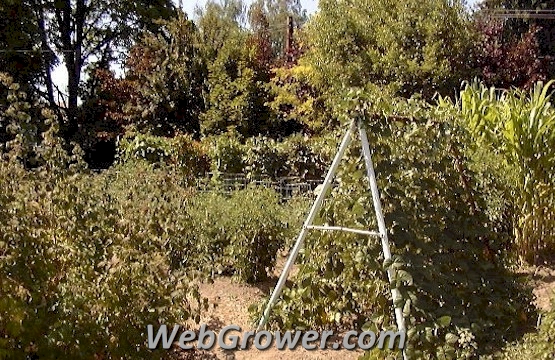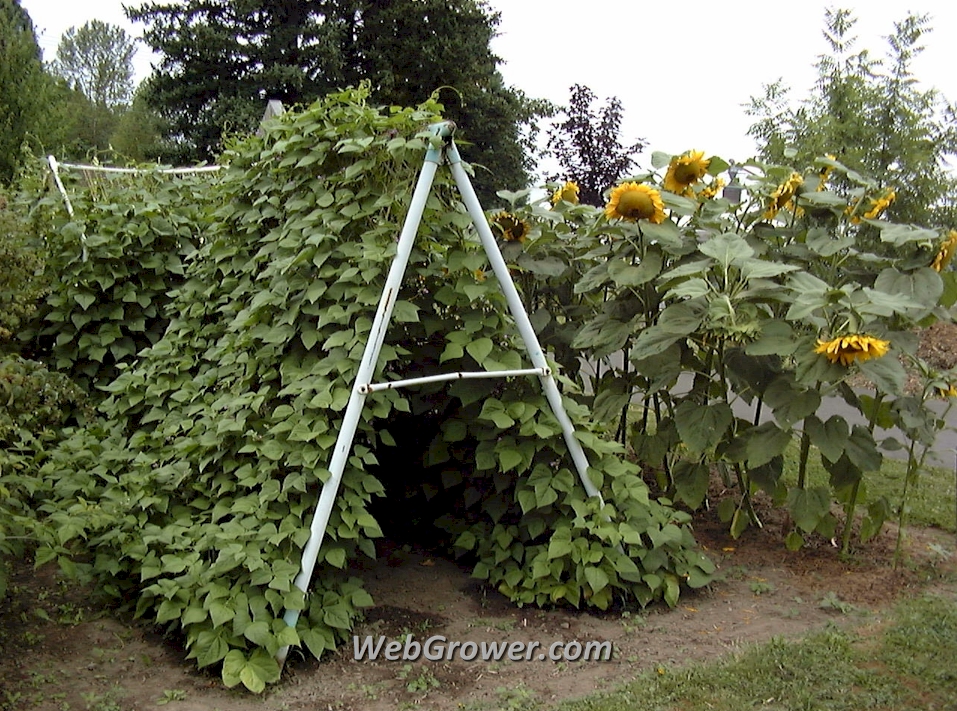Homepage → Gardening Related Topics → Bean Support and Trellising Ideas
Bean Support and Trellising Ideas
Planted May 27, 2001
Last tended to on October 15, 2024
Reading time: 4 minutes

Bean Growing & Trellising On Our Farm:
Examples From Our Gardens
by Mike Dunton
The methods of supporting pole or runner beans is limited only by your imagination. The ideas and images presented here are of methods that we use, or have used, here on the farm. Some are best suited for larger scale production, others are wonderfully suited for a smaller garden plot.
Row Trellising Systems
This first method is the one that we employed here for many, many decades. It was basically the way that all of the commercial bean farmers raised beans here in the Willamette Valley until bush-type varieties and mechanical harvesters took over.

In the northern portion of the Willamette Valley where we are located, snap bean production was a major part of the agricultural economy in the past. My parent’s childhoods in the 1940s and 1950s included spending summers picking berries and beans. It was the major source of income for many school kids.

The beans produced were almost exclusively pole-type varieties grown on a string trellising system similar to the one illustrated in the above photographs. Note: The poles in the photos are eight foot metal T-posts. Using ten foot poles would be beneficial.
Installation: The system is simple – but time consuming – to erect every spring and remove every fall. Tall steel T-posts are pounded into the ground at the ends of the rows with wire stretched between them at the top and bottom. Additional T-posts are used in between the end poles to help support the wires as necessary. Heavy string or twine is laced between the top and bottom wires. The material that we use is natural sisal fiber, untreated, and biodegradable. The beans then wrap themselves around the string as they grow upwards.
We source our binder twine wherever we can find it at the best price. Local farm supply stores are one option; online is another. Keep in mind that you will be stringing up and down between the top and bottom wires, about every six inches, all the way down your rows. Take this into consideration when calculating the number of feet that you will need.
 If you click on the image above, you will be directed to various options at Amazon.
If you click on the image above, you will be directed to various options at Amazon.
Since the twine that we use is biodegradable, it is removed and composted with the expended vines in the late fall after we are finished harvesting the beans. Wires and pole are removed and stored, a cover crop planted, and the system is installed in a different location the following year.
Although this methods has its roots in the commercial bean fields of the past, it is quite easily adapted to the home garden. The poles, wire and twine are available at farm, garden and home supply stores. Although the twine is expendable, the poles and wire will last for decades.
Swing Set Trellis

As part of a thrifty and responsible lifestyle, reuse, repurposing and recycling is something we advocate and practice. Our garden, as part of our lives, is the perfect place in which we practice.
In this example, we used the frame of an old swing set as the support structure for stringing up beans, and also a fun place for kids to play in.

Fun in the Garden – Build a “Bean House”
Gardening should not be a chore. It should be a place of relaxation, reward, and fun! The following images are of our “Bean House.”

Fig. 1 – The house’s facade attached to the core structure of PVC pipe.

Fig. 2 – The bean house a couple of months later.
The main part of the facade is made from a piece of 1/2" exterior plywood. The “beams” were created by screwing 1/2" x 3" scrap fir and cedar. The “wattle and daub” effect by using FixAll brand plaster. The plaster and the beams were left to weather naturally. The other portions were stained dark brown. There is a hinged door cut out of the plywood that allows kids to play inside and access to pick when the time comes.
The frame of the “house” is created out of PVC pipe. Twine is then laced, from top to bottom rails, as in the other examples above. T-posts are used as to anchor and support the structure. Note: The pipe is dry fit together, not glued, allowing us to disassemble and easily store it for the winter.
This type of structure helps to create interesting spaces that inviting people into the garden. The idea is to have fun and create positive memories. This is one of the best ways to ensure that gardening is passed on to future generations.
Mike Dunton is an "heirloom seed pioneer" who founded, and is the former owner of, the Victory Seed Company. As a seed professional, biodiversity preservationist, horticultural historian, technologist, farmer, gardener, homesteader, writer, and educator, he has worked for decades to share the knowledge and experience that he has gained over a lifetime of trial and error. He strives to pass down his passion for incorporating "old-timey skills" into our everyday, modern lives.
Copyright © 1998 - 2025 - All rights reserved
WebGrower.com℠ is a service mark of Victory Horticultural Group, LLC.
• Privacy Statement •
This site participates in the Amazon Services LLC Associates Program, an affiliate advertising program designed to provide a means for sites to earn advertising fees by advertising and linking to amazon.com.